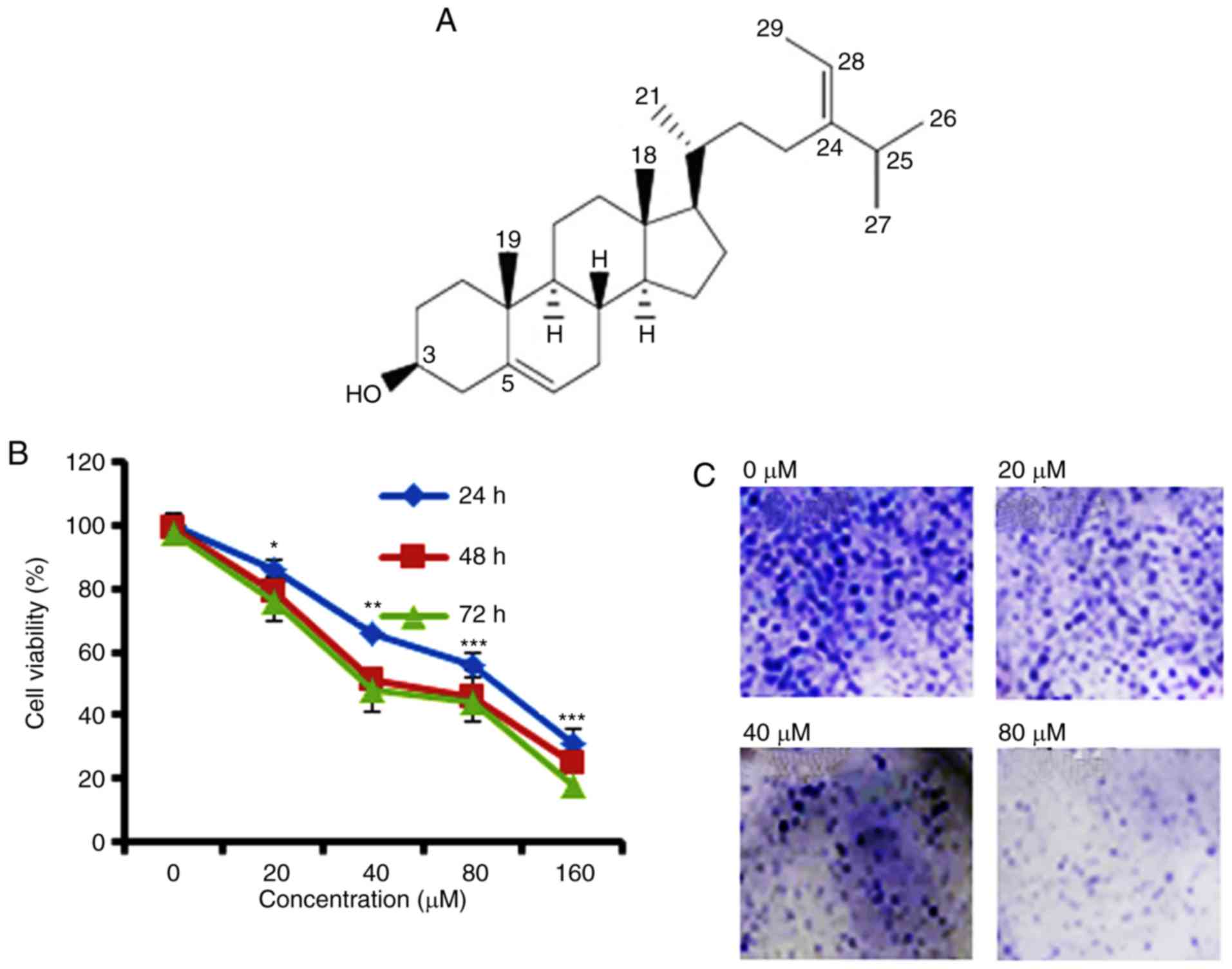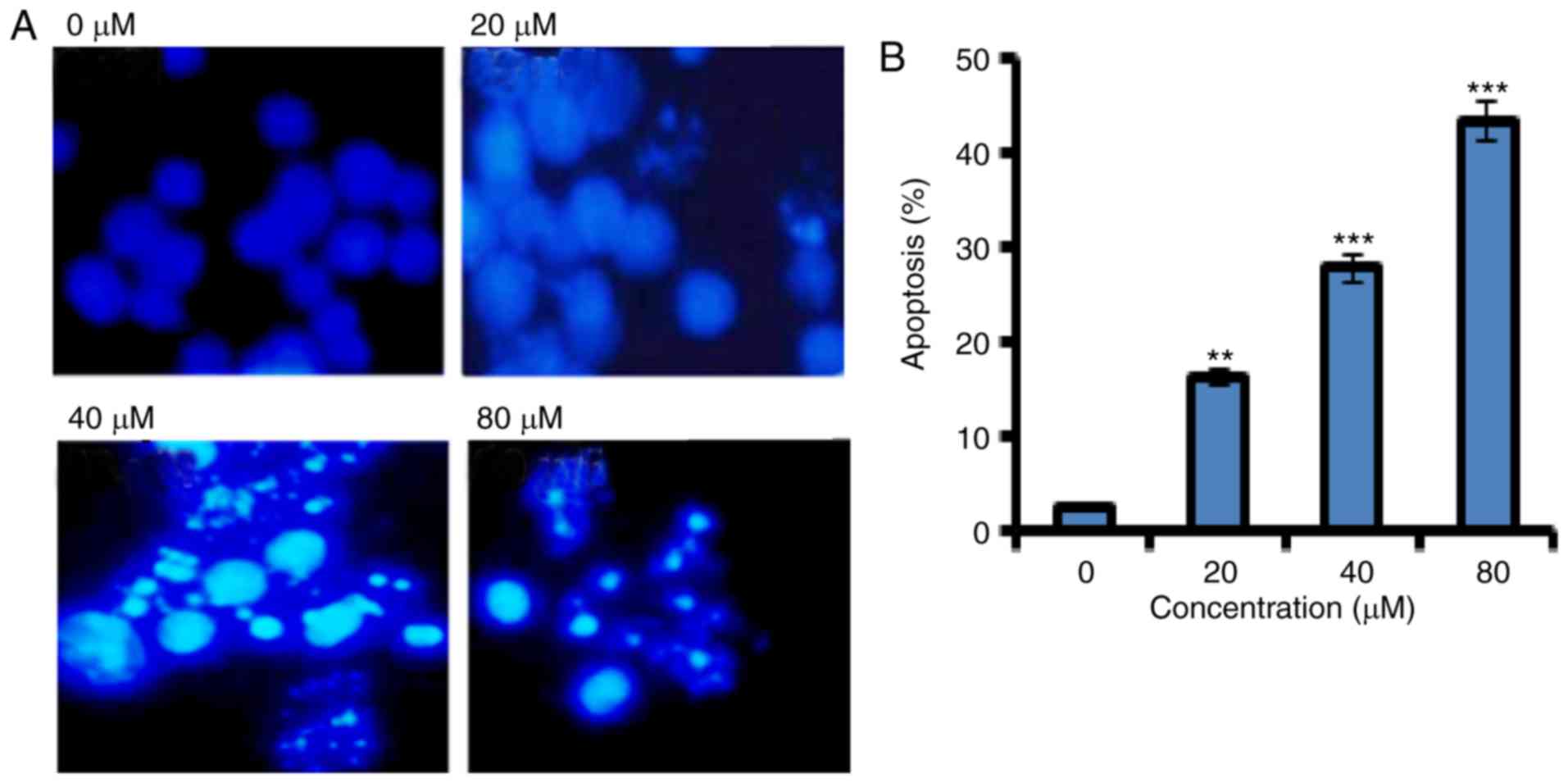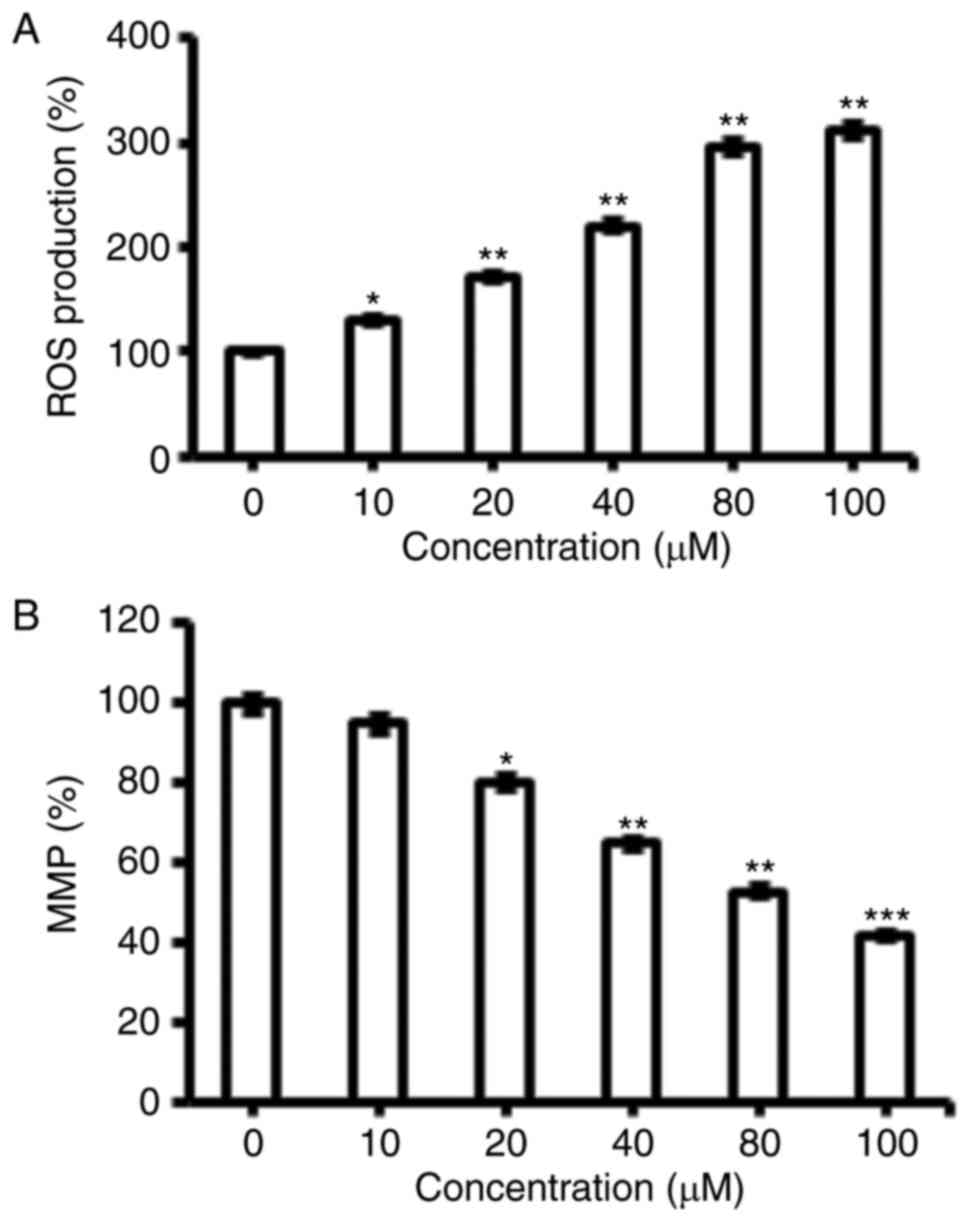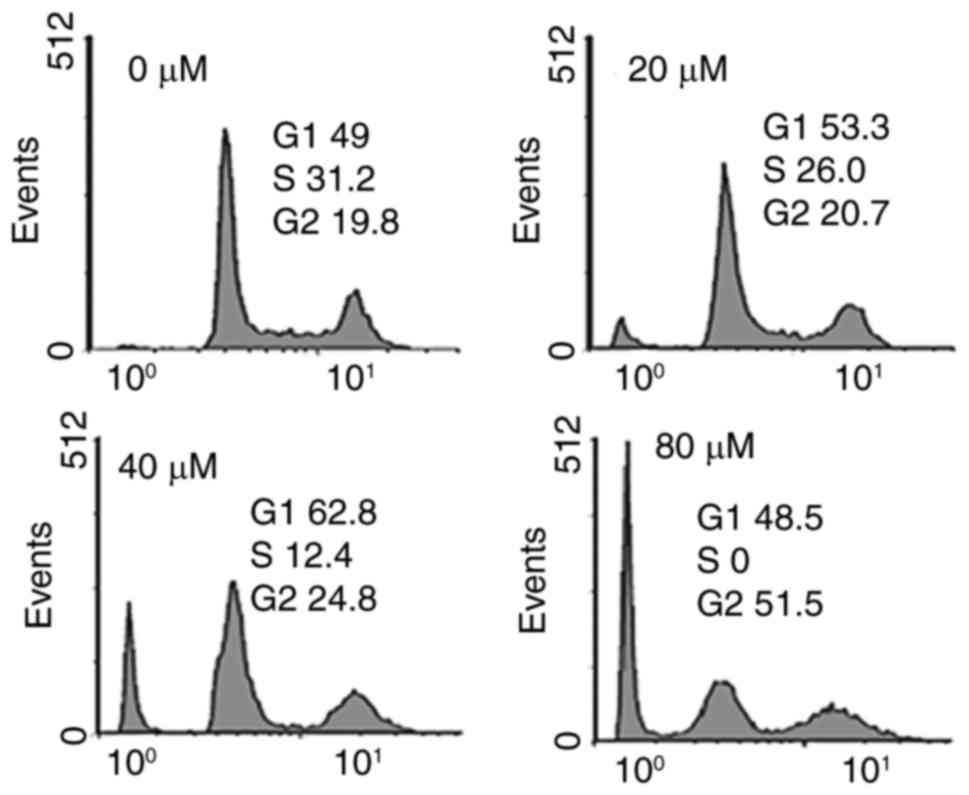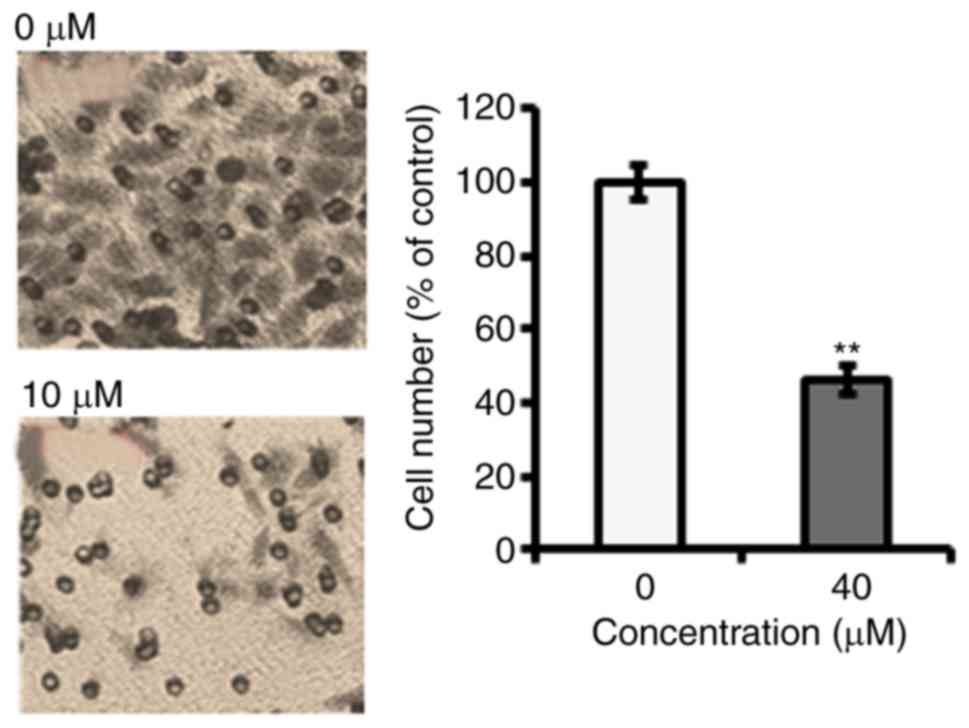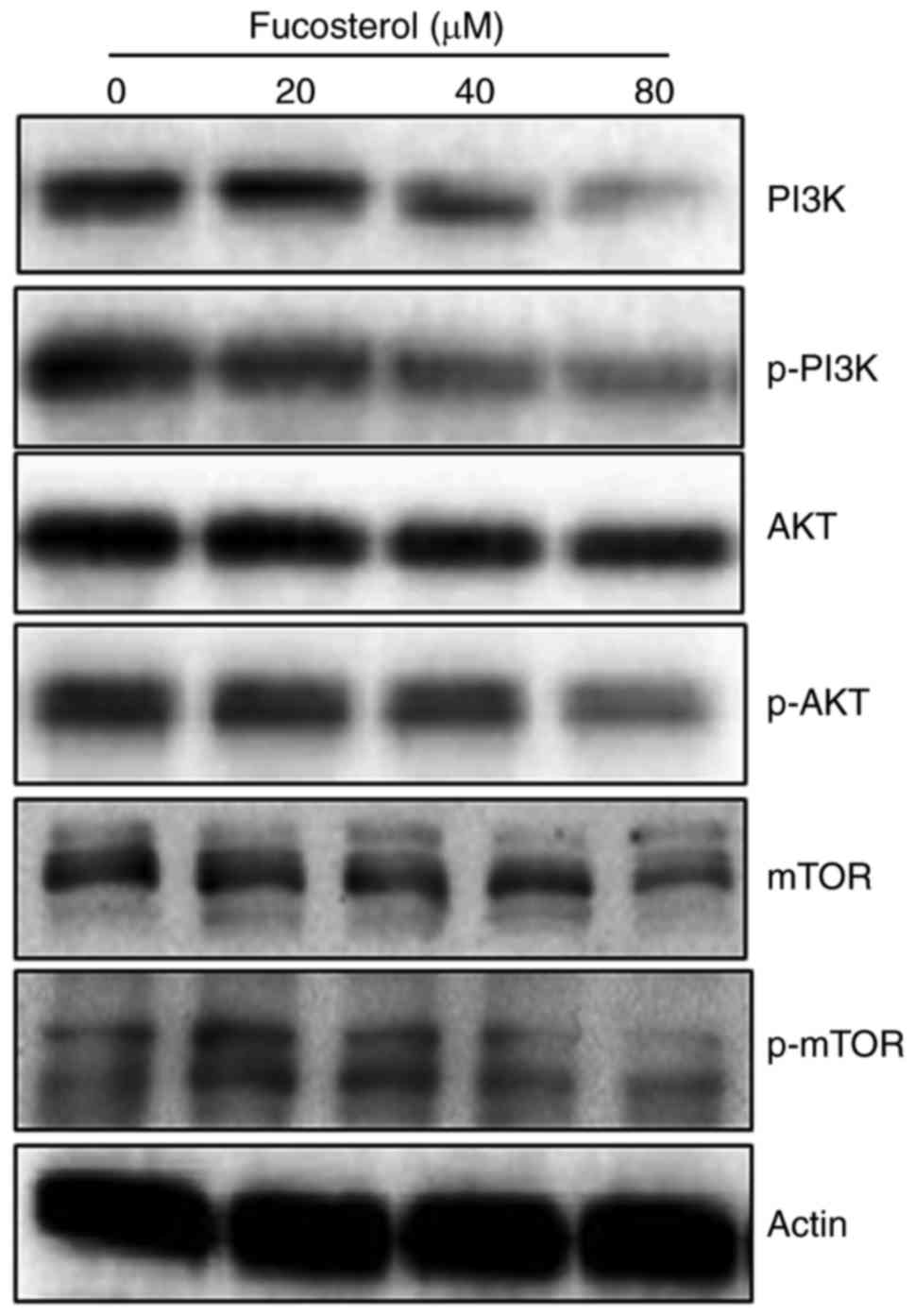Fucosterol exhibits selective antitumor anticancer activity against HeLa human cervical cell line by inducing mitochondrial mediated apoptosis, cell cycle migration inhibition and downregulation of m-TOR/PI3K/Akt signalling pathway
Retraction in: /10.3892/ol.2022.13618
- Authors:
- Published online on: January 10, 2018 https://doi.org/10.3892/ol.2018.7769
- Pages: 3458-3463
-
Copyright: © Jiang et al. This is an open access article distributed under the terms of Creative Commons Attribution License.
Abstract
Introduction
Cervical cancer ranks third among the most frequently detected cancer in women around the globe. Every year more than 500,000 women are diagnosed for this disease which approximately accounts for about 9% of the total newly diagnosed cancer cases (1). Nevertheless, existing treatment options including radical hysterectomy and radiotherapy have decent clinical outcomes, still around 300,000 deaths are accredited to cervical cancer annually. Moreover, surgery is lone and appropriate option for early stage cervical cancer and radiotherapy exhibits severe side effects which badly influence the quality of life (2). Natural products have gained tremendous importance as anticancer agents due to their lower side effects. Among these, anticancer marine plants form one of the important sources for isolation of anti-cancerous molecules (3). Recently, a compound fucosterol (Fig. 1A) has been shown toexhibit tremendous pharmacological potential activities have been attributed to this molecule which include, but are not limited to anticancer, antidepressant, anticonvulsant, anti-inflammatory, and antimicrobial (3,4). Here in the present study a natural product, fucosterol was evaluated against human cervical cells. Moreover, the probable underlying mechanism was assessed with particular emphasis on the effect of this natural product on PI3K/Akt/mTOR cascade. Except for p53 signaling pathway, the PI3K/Akt/mTOR cascade is probably the most recurrently changed signaling pathway in cancer (5). Consistent with this, first generation mTOR inhibitors exhibit significant anti-cancer properties and several have even been approved for the management of several types of cancers which include, but are not limited to pancreatic, cervical, renal and breast cancers. Additionally, PI3K, Akt together with second generation inhibitors of mTOR are undergoing clinical trials (5,6). Of note, the results of the present study indicated that fucosterol exhibits a significant anticancer activity by inducing apoptosis in human cervical HeLa cancer cell line by reactive oxygen species (ROS) mediated alterations in mitochondrial membrane potential (ΔΨm) and cell cycle arrest. It was also found to downregulate the expression key proteins of PI3K/Akt/mTOR signalling pathway. Additionally, fucosterol also caused significant inhibition on cell migration. Taken together, we propose that fucosterol may prove a potential candidate towards the management of cervical cancer.
Materials and methods
Chemicals and reagents
Fucosterol, propidium iodide (PI), RNase A triton X-100 dimethyl and sulfoxide (DMSO), were obtained from Sigma-Aldrich Co. (St. Louis, MO, USA). All primary and secondary antibodies were purchased from Santa Cruz Biotechnology Inc. (Santa Cruz, CA, USA). The fluorescent probes DCFH-DA, DiOC6, 4′-6-diamidino-2-phenylindole (DAPI), Fetal bovine serum (FBS), RPMI-1640 medium, L-glutamine, antibiotics were obtained from Invitrogen Life Technologies (Carlsbad, CA, USA).
Cell line and culture conditions
Human cancer cell lines, human lung cancer cell line (A-549), pancreas (MiaPaca-2), prostate (PC-3, CVCL_0035), breast (MCF-7), gastric cancer cell line (SNU-5), cervical cancer cell line (HeLa) and human normal cell line (fR2) were procured from Cancer Research Institute of Beijing, China, and it was maintained in DMEM and was supplemented with 10% FBS and antibiotics (100 µg/ml streptomycin and 100 U/ml penicillin G) in a incubator at 37°C (5% CO2 and 95% air).
MTT assay
The anti-proliferation effect of fucosterol was evaluated against a panel of human cancer cell linesby MTT assay. Cells were grown at 1×106 cells per well in 96-well plates for a time period of 12 h and then exposed to different concentration of fucosterol (0–160 µM) for 48–72 h. To each well, MTT solution (20 µl) was added. Prior to the addition of 500 µl of DMSO, the medium was completely removed. To solubilize MTT formazan crystals, 500 µl DMSO was added. ELISA plate reader was used for the determination of optical density. Since an lowest IC50 was observed for HeLa cervical cancer cell line, they were subjected to further evaluation at the doses of 0, 20, 40 and 80 µM of fucosterol dose for 24, 48 and 72 h. We selected one dose lower and one dose higher than the IC50 of fucosterol.
Colony formation assay
For clonogenic assay, cervical cancer HeLa cells at the exponential growth phase were harvested and counted with a hemocytometer. Seeding of the cells was done at 200 cells per well, incubated for a time period of 48 h to allow the cells to attach and then to the cell culture different doses (0, 20 40 and 80 µM) of fucosterol was added. After treatment, the cells were again incubated for 6 days, washing was done with PBS and methanol was used to fix colonies and then stained with crystal violet for about 30 min before being counted under light microscope.
DAPI staining
HeLa cells at a density of 2×105 cells/well were seeded in 6-well plates were administrated with 0, 20, 40 and 80 µM fucosterol for 48 h. The cells were then subjected to DAPI staining. Afterwards, the cell sample was studied and photographs taken under fluorescence microscopy as previously described (7).
Determination of ROS, and ΔΨm
HeLa cells were seeded at a density of 2×105 cells/wel in a 6-well plate and kept for 24 h and treated with (0–100 µM) fucosterol for 48 h at 37°C in 5% CO2 and 95% air. Thereafter cells from all samples were collected, washed 2 times by PBS and re-suspended in 500 µl of DCFH-DA (10 µM) for ROS estimation and DiOC6 (1 µmol/l) for ΔΨm at 37°C indark room for 30 min. The samples were then examined instantly using flow cytometer as described previously in literature (8).
Determination of cell cycle distribution of HeLa cells
The cells seeded in 6 well plates (2×105 cells/well) and fucosterol was administrated to the cells at the doses of 0, 20,40 and 80 µM followed by 24 h of incubation. DMSO was used as a control. For estimation of DNA content, PBS was used to wash the cells and fixed in ethanol at −20°C. This was followed by re-suspension in PBS holding 40 µg/ml PI and, RNase A (0.1 mg/ml) and Triton X-100 (0.1%) for 30 min in a dark room at 37°C. Afterwards, analysis was carried out by flow cytometry as reported previously (9).
Cell migration assay
Cell migration assay was carried out by Boyden chamber assay with some modifications. Cells at the density of 5×104 cells/well were suspended in 2% FBS medium and placed in the upper chamber of 8 µm pore size transwells. After wards, medium supplemented with 10% FBS was added to lower chamber. This was followed by an incubation of 48 h. On the upper surface of the membrane, unmigrated cells were removed while as on the lower surface of the membrane the migrated cells were fixed in methanol (100%) and Giemsa stained. The cell migration was estimated by counting the number of the migrated cells under a microscope.
Western blotting analysis
The fucosterol administrated cells were harvested and lysed. The protein concentrations of the lysates were quantified by BCA assay using specific antibodies. β-actin was used as a control. From each sample equal amounts of protein were loaded and separated by electrophoresis on a 12% denaturing SDS gel. Afterwards, the proteins were then electroblotted on polyvinylidene difluoride membranes (0.45 m pore size).
Statistical analysis
All experiments were carried out in triplicates and expressed as mean ± standard deviation (SD). Statistical analysis was carried by Students t-test and one way ANOVA (in case of comparisons between more than two groups) using Tukey's HSD test. GraphPad prism 7 software (GraphPad Software, Inc, USA). The values were considered significant at *P<0.01, ** P<0.001, ***P<0.0001.
Results
Anti-proliferative potential of fucosterol on Cervical HeLa cancer cell line
To identify the anti-proliferative role of fucosterol was evaluated against a panel of human cancer cell lines (Table I). However, fucosterol exhibited selective anticancer activity against cervical cancer HeLa cells in a dose dependent manner and exhibited an IC50 40 µM (Table I and Fig. 1B). In the colony formation assay, we observed that fucosterol administration reduced the number of colonies in a dose-dependent manner (Fig. 1C).
Fucosterol induced apoptosis in human HeLa cervical cancer cells
In order to confirm apoptotic cell death induced by fucosterol Annexin V/PI staining was performed. Flow cytometric results showed that the percentage of apoptotic cell population increased to 12.2, 37 and 62 % in HeLa cancer cells after 48 h at the concentrations of 20, 40 and 80 µM, respectively as compared to untreated control (Fig. 2). Thus the results indicate that the extract caused apoptotic cell death in a concentration dependent manner.
Fucosterol triggered the ROS activation in human HeLa cervical cancer cells
The pro-apoptotic potential of fucosterol observed through DAPI staining study suggested that fucosterol might induce generation of intracellular ROS. Therefore, we calculated the ROS level at varied concentrations of fucosterol for 48 h. The results showed that the intracellular ROS levels of treated cells increased 110 to 305% as compared to untreated cells (Fig. 3A). Our result suggested that fucosterol is a potent molecule for activating ROS in HeLa cells to trigger the apoptosis.
Fucosterol reduces the mitochondrial membrane potential (ΔΨm)
ROS generationis related to mitochondrial dysfunction. It disrupts the outer mitochondrial potential to release the death-promoting proteins (10). Therefore, we examined whether fucosterol reduces the ΔΨm in HeLa cells treated with fucosterol at varied concentrations. Fucosterol treated HeLa cells showed a significant reduction in ΔΨm in a dose-dependent manner (Fig. 3B).
Fucosterol caused alterations in cell cycle distribution of HeLa cancer cells
It was observed that the percentage of cells was considerably increased in G2 at the concentrations of 0 to 80 µM concentrations of fucosterol causing G2 arrest (Fig. 4). Additionally the populations of HeLa cells G2 phase were marginally increased at a dose of 20 µM, reasonably increased at 20 µM, and dramatically increased at 40 µM. This fucosterol-induced G2 increase of HeLa cancer cells was observed to exhibit a dose-dependent pattern.
Fucosterol inhibits cell migration
Further, we investigated fucosterol can inhibit the migration of cervical cancer cells at the IC50 concentration (40 µM). The results of transwell assays showed that fucosterol reduced the migratory capability of cervical cancer HeLa cells (Fig. 5).
Fucosterol targets m-TOR/PI3K/Akt signalling pathway
The fact that fucosterol could modulate the protein expressions of m-TOR/PI3K/Akt signalling pathway, we carried out the western blot analysis. The findings are shown in (Fig. 6) and indicate an interesting outcome. Compared to the untreated control cells, fucosterol treated cells showed a concentration-dependent downregulation of m-TOR and pm-TOR proteins. It also caused marked downregulation of PI3K/Akt protein expressions. Thus it may be concluded that fucosterol induced anticancer and apoptotic effects partly via m-TOR/PI3K/Akt signalling pathway.
Discussion
Cervical cancer is one of the major cancers detected in women around the globe. Around 500,000 women are diagnosed for this disease annually (1). Nevertheless, the treatment options for cervical cancer are limited. Moreover, surgery is the only appropriate choiceif the cancer is detected at an early stage. Other options such as radiotherapy have severe side effects which badly influence the quality of life (2). Against this backdrop, molecules from natural sources with limited side effects may prove handy. In the current study, fucosterol showed potential and selective growth inhibiting activity against HeLa cervical cancer cells as evident from the proliferation assay. The selective anticancer activity of fucosterol on HeLa cells is interesting. It may be explained by the fact that several anticancer agents tend exhibit selective anticancer effects against particular cell line due to the involvement specific signalling pathways in different cancer types (10). However, it would be too early to delimit any particular reason for the selective anticancer effects of fucosterol and thus will require further investigation in future. As reported previously, many drugs exhibit antiproliferative effects via induction of apoptosis. For instance, several chemotherapeutic drugs, such as cisplatin, taxol and 5-fluorouracil (11–17) have been reported to alter explicit apoptotic pathways. Additionally, resistance to drug is partially explained by the ability of cancer cells to flee apoptosis (18). To asses weather fucosterol induces apoptosis in HeLa cells, we carried out the DAPI staining of the fucosterol treated cells. It was observed that fucosterol induces apoptosis in a concentration dependent manner. Further it was observed that fucosterol treated cells displayed ROS mediated MMP reduction. Our results are in agreement with studies carried out previously (17). Therefore the results suggest that fucosterol may induce apoptosis through increasing intracellular ROS and reduction in MMP. Several anti-cancer drugs target cancer cells partly by accretion of high levels of ROS (18). Moreover, mitochondria play a key role in ROS (19). For example, capsaicin disrupts MMP and mediates oxidative stress resulting in apoptosis in pancreatic cancer cells (11–17). Flow cytometry using propidium iodide as a probe was used to study effects of fucosterolon cell cycle progression. Fucosterol induced G2/M cell cycle arrest and led to a significant increase of G2 cells in a dose dependently. Further, it was shown that fucosterol could inhibit HeLa cancer cell in a concentration dependent manner. These findings are promising since it is well established that cervical cancer is one of the most lethal cancers and fucosterol could inhibit this behavior. Additionally, fucosterol also inhibited the cell migration of HeLa cells as evident from the transwell assays. This migration inhibiting potential indicates that fucosterol may prove beneficial in inhibiting the metastasis of cancer cells in vivo and therefore deserves further investigation.
Akt and mTOR are well-known major regulatory signaling cascade that control cell proliferation, metabolism and survival of cancer cells. Therefore, several inhibitors, such as everolimus, have been developed and used for treatment to induce apoptosis in cancer cells. To inhibit the mTOR signaling pathway, rapamycin has been used in several studies. However, rapamycin only inhibits mTOR complex (TORC) 1, and it consequently induces Akt phosphorylation via feedback activation (20,21) Thefore we investigated the effects of fucosterol on PI3/Akt/mTOR pathway. Our results indicated that the expression levels of various proteins including m-TOR, pm-TOR, PI3K, p-PI3K and Akt were downregulated as evident from the western blot assay. These results indicate the potential of fucosterol to inhibit cancer cell growth via inhibition of PI3K/Akt/mTOR pathway. Though our results showed promising activity of fucosterol, the feasibility of uses of fucosterol in human and its bioavailability will require further in vivo studies However, the low toxicity of fucosterol towards normal cancer cells indicated that it could be used at even at the concentrations that 4 times higher than its IC50.
Taken together, we conclude that fucosterol may prove a potential candidate for the treatment of cervical cancer by regulating m-TOR/PI3K/Akt signalling pathway. With limited drug options available and limited toxicity associated with this naturally occurring fucosterol, this molecule seems a strongoption and deserves further research endeavors.
References
|
Jemal A, Bray F, Center MM, Ferlay J, Ward E and Forman D: Global cancer statistics. CA Cancer J Clin. 61:69–90. 2011. View Article : Google Scholar : PubMed/NCBI | |
|
Cadron I, Van Gorp T, Amant F, Leunen K, Neven P and Vergote I: Chemotherapy for recurrent cervical cancer. Gynecol Oncol. 107(1 Suppl 1): S113–S118. 2007. View Article : Google Scholar : PubMed/NCBI | |
|
Blunden G: Biologically active compounds from marine organisms. Phytother Res. 15:89–94. 2001. View Article : Google Scholar : PubMed/NCBI | |
|
Zhen XH, Quan YC, Jiang HY, Wen ZS, Qu YL and Guan LP: Fucosterol, a sterol extracted from sargassum fusiforme, shows antidepressant and anticonvulsant effects. Eur J Pharmacol. 768:131–138. 2015. View Article : Google Scholar : PubMed/NCBI | |
|
Engelman JA: Targeting PI3K signalling in cancer: Opportunities, challenges and limitations. Nat Rev Cancer. 9:550–562. 2009. View Article : Google Scholar : PubMed/NCBI | |
|
Romashkova JA and Makarov SS: NF-kappaB is a target of AKT in anti-apoptotic PDGF signalling. Nature. 401:86–90. 1999. View Article : Google Scholar : PubMed/NCBI | |
|
Chiang LC, Ng LT, Lin IC, Kuo PL and Lin CC: Anti-proliferative effect of apigenin and its apoptotic induction in human Hep G2 cells. Cancer Lett. 237:207–214. 2006. View Article : Google Scholar : PubMed/NCBI | |
|
Chiang JH, Yang JS, Ma CY, Yang MD, Huang HY, Hsia TC, Kuo HM, Wu PP, Lee TH and Chung JG: Danthron, an anthraquinone derivative, induces DNA damage and caspase cascades-mediated apoptosis in SNU-1 human gastric cancer cells through mitochondrial permeability transition pores and bax-triggered pathways. Chem Res Toxicol. 24:20–29. 2011. View Article : Google Scholar : PubMed/NCBI | |
|
Sun SY, Hail N Jr and Lotan R: Apoptosis as a novel target for cancer chemoprevention. J Natl Cancer Inst. 96:662–672. 2004. View Article : Google Scholar : PubMed/NCBI | |
|
Stierle AA, Stierle DB and Kelly K: Berkelic acid, a novel spiroketal with selective anticancer activity from an acid mine waste fungal extremophile. J Org Chem. 71:5357–5360. 2006. View Article : Google Scholar : PubMed/NCBI | |
|
Maitra R, Porter MA, Huang S and Gilmour BP: Inhibition of NFkappaB by the natural product Withaferin A in cellular models of Cystic Fibrosis inflammation. J Inflamm (Lond). 6:152009. View Article : Google Scholar : PubMed/NCBI | |
|
Hissin PJ and Hilf R: A fluorometric method for determination of oxidized and reduced glutathione in tissues. Anal Biochem. 74:214–226. 1976. View Article : Google Scholar : PubMed/NCBI | |
|
Chipuk JE, Bouchier-Hayes L and Green DR: Mitochondrial outer membrane permeabilization during apoptosis: The innocent bystander scenario. Cell Death Diff. 13:1396–1402. 2006. View Article : Google Scholar | |
|
Azuma M, Tamatani T, Ashida Y, Takashima R, Harada K and Sato M: Cisplatin induces apoptosis in oral squamous carcinoma cells by the mitochondria-mediated but not the NF-kappaB-suppressed pathway. Oral Oncol. 39:282–289. 2003. View Article : Google Scholar : PubMed/NCBI | |
|
Yoneda K, Yamamoto T and Osaki T: p53- and p21-independent apoptosis of squamous cell carcinoma cells induced by 5-fluorouracil and radiation. Oral Oncol. 34:529–537. 1998. View Article : Google Scholar : PubMed/NCBI | |
|
Abal M, Andreu JM and Barasoain I: Taxanes: Microtubule and centrosome targets, and cell cycle dependent mechanisms of action. Curr Cancer Drug Targets. 3:193–203. 2003. View Article : Google Scholar : PubMed/NCBI | |
|
Ferreira CG, Epping M, Kruyt FA and Giaccone G: Apoptosis: Target of cancer therapy. Clin Cancer Res. 8:2024–2034. 2002.PubMed/NCBI | |
|
Malaguarnera L: Implications of apoptosis regulators in tumorigenesis. Cancer Metastasis Rev. 23:367–387. 2004. View Article : Google Scholar : PubMed/NCBI | |
|
Ding H, Han C, Guo D, Chin YW, Ding Y, Kinghorn AD and D'Ambrosio SM: Selective induction of apoptosis of human oral cancer cell lines by avocado extracts via a ROS-mediated mechanism. Nutr Cancer. 61:348–356. 2009. View Article : Google Scholar : PubMed/NCBI | |
|
Radhakrishnan P, Baraneedharan U, Veluchamy S, Dhandapani M, Pinto DD, Thiyagarajan S, Thayakumar A, Prasath A, K A, Velu A, et al: Inhibition of rapamycin-induced AKT activation elicits differential antitumor response in head and neck cancers. Cancer Res. 73:1118–1127. 2013. View Article : Google Scholar : PubMed/NCBI | |
|
Khursheed A, Rather MA and Rashid R: Plant-based natural compounds and herbal extracts as promising apoptotic agents: Their implications for cancer prevention and treatment. Bio Med Pharma. 3:245–269. 2016. |



